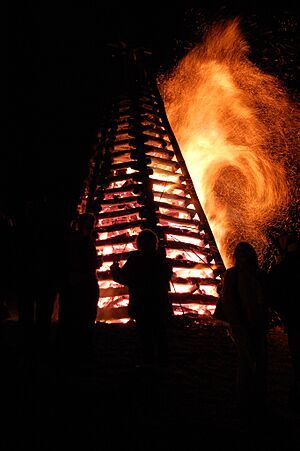Bonfire Night facts for kids
Bonfire Night is a special time of year when people light big outdoor fires called bonfires. They often celebrate with bright fireworks too! This tradition happens on different dates around the world. For example, it's celebrated as Guy Fawkes Night on November 5th in Great Britain. Other Bonfire Nights happen on All Hallows' Eve (October 31st), May Eve (April 30th), and Midsummer Eve (June 23rd).
Contents
Why Do People Celebrate Bonfire Night?
Guy Fawkes Night in Great Britain
In Great Britain, Bonfire Night is mostly about remembering a failed plot from November 5, 1605. A man named Guy Fawkes tried to blow up the Houses of Parliament. He was caught, and the plot failed. So, people celebrate that the plan didn't work out!
Today, this celebration on November 5th is mostly for fun. Families gather to watch bonfires and fireworks. Often, they burn a dummy, or "effigy," of Guy Fawkes on the fire. These celebrations happen all over Great Britain. You can also find them in some parts of the Commonwealth, like South Africa and Newfoundland and Labrador in Canada. Many events also have fun rides, entertainment, and special treats.
Bonfire Nights in Ireland
In Northern Ireland, "Bonfire Night" can mean the celebrations on July 11th. This night remembers the Battle of the Boyne from 1690. In this battle, the Protestant King William of Orange won against the Catholic King James II. This date still holds strong meaning for many people there.
In the city of Cork and many country areas of the Republic of Ireland, "Bonfire Night" is on June 23rd. This is Saint John's Eve. It started as a religious celebration where people prayed for good crops. This night is also linked to the summer solstice, which is the longest day of the year. Long ago, fires were lit to honor a goddess named Áine. Later, this old festival became connected to the birth of Saint John.
In the city of Limerick, "Bonfire Night" is on April 30th. This is May Eve, which is the night before the old Celtic festival of Bealtaine.
Staying Safe and Protecting the Environment
Safety Concerns
Bonfire celebrations can sometimes be risky. There's a chance of fires, injuries, or even arguments. For example, in London, fire services get many more calls on Bonfire Night. In Belfast, a July 2003 celebration caused a lot of damage to a park. Fireworks can also be dangerous if not used carefully. Because of safety worries, some places, like parts of the Caribbean and New Zealand, have rules about using fireworks. However, public firework shows are still very popular.
Environmental Impact
Some people worry about how Bonfire Night affects the environment. A study in Oxford, England, in 1994 found that the air had more harmful chemicals called dioxins after a Bonfire Night. In 2005, a Bonfire Night in Newfoundland led to officials reminding people to be careful for both safety and the environment.
Delicious Bonfire Night Food
Many yummy foods are enjoyed during Bonfire Night celebrations. In parts of England, people traditionally eat toffee apples, treacle toffee, black peas, and a cake called parkin. You might also find hog roasts or jacket potatoes. Some families like to eat warm soups on a chilly night. And, of course, toasting marshmallows over the fire is a favorite activity!
See also
 In Spanish: Noche de hoguera para niños
In Spanish: Noche de hoguera para niños


